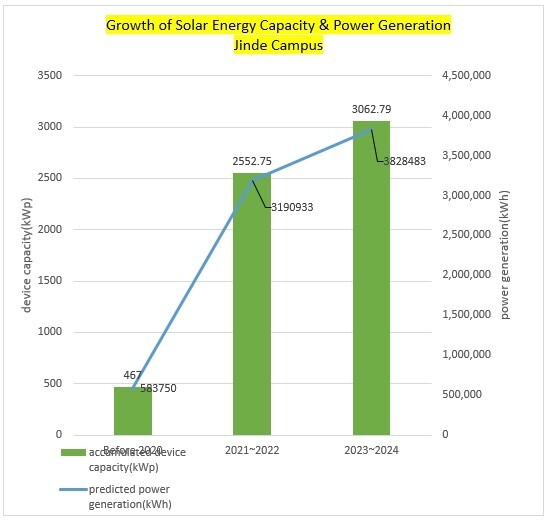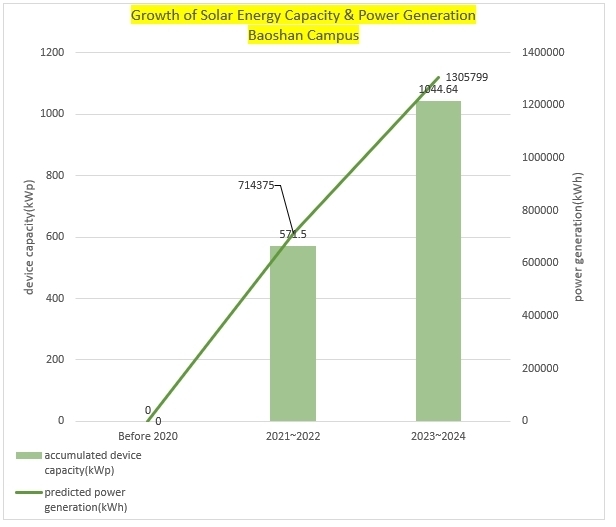SDG13.2.2 Total energy used
The total power consumption of Jinde Campus in 2021 was 8,711,600 kWh, that of Baoshan Campus was 3,639,000 kWh, and the total consumption of NCUE was 12,350,600kWh (= 44,462.16 GJ)
Remark: The total power consumption in 2021 was calculated with Gigajoule (GJ).
Total energy used in 2021 in Gigajoule (GJ)
Total energy used from low-carbon sources
1. In 2017, Jinde Campus installed a photovoltaic solar power system that generated 467kwp of power. As of July 2022, the cumulative power generated by solar energy has exceeded 2.9 million kWh (> 10,440 GJ), with an average annual power generation of 583,750 kWh (2,101.5GJ), accounting for 4.73% of the total power consumption of NCUE in 2021.
2. It is expected that in academic year 2021–2022, the annual solar power generation of Jinde Campus will increase to 3,190,933 kWh (11,487GJ), and that of Baoshan Campus will increase to 714,375 kWh (2,572GJ), which will account for more than 30% of NCUE’s total power consumption for the academic year.
3. For academic year 2023–2024, there are plans to further increase the annual solar power generation capacities to 3,828,483 kWh (13,782GJ) and 1,305,799 kWh (4,700GJ), respectively, on Jinde and Baoshan Campuses.
4. It is estimated that by 2024, NCUE’s total solar power generation will reach 5,134,282 kWh (18,483GJ), which would represent 40% of the total power consumption in 2021.
5. The table below summarizes NCUE’s use of low carbon energy from 2021 to 2024.
|
Campus |
Year |
Newly Added Capacity (kWp) |
Accumulated Capacity (kWp) |
Expected Power Generation (kWh) |
% of Total Power Consumption in 2021 |
|
Jinde |
Before 2020 |
467 |
467 |
583,750 |
6.7% |
|
2021-2022 |
2085.75 |
2552.75 |
3,190,933 |
36.63% |
|
|
2023-2024 |
510.04 |
3062.79 |
3,828,483 |
43.95% |
|
|
Baoshan |
Before 2020 |
0 |
0 |
0 |
0% |
|
2021-2022 |
571.5 |
571.5 |
714,375 |
19.63% |
|
|
2023-2024 |
473.14 |
1044.64 |
1,305,799 |
35.88% |
|
|
Total |
Before 2020 |
467 |
467 |
583,750 |
4.73% |
|
2021-2022 |
2657.25 |
3124.25 |
3,905,308 |
31.62% |
|
|
2023-2024 |
983.18 |
4107.43 |
5,134,282 |
41.57% |
6. NCUE is striving for carbon neutrality. Prior to 2020, during peak hours, solar energy generated on Jinde campus was 467 kw, and low-carbon energy accounted for approximately 15.57% of total power consumption (3,000 kW), whereas Baoshan campus consumed 1,000 kw, which was not from low-carbon sources.
7. It is expected that in academic year 2021–2022, total solar energy generated on Jinde Campus will increase to 2,552.75 kw during peak hours, whereas power consumption will reduce to 2,600 kw, which will push low-carbon energy sources to 98.18% of the total energy consumed. On Baoshan Campus, solar power generation is expected to increase to 571.5 kw during peak hours, whereas power consumption is expected to reduce to 900 kw, increasing low-carbon energy sources to 63.5% of the total power consumed.
8. The target for academic year 2023–2024 is to increase solar power generation to 3,062.79 kw during peak hours and reduce power consumption to 2,400 kw on Jinde Campus, with low-carbon energy exceeding 100% of the total energy consumed. Similarly, for Baoshan Campus, it is expected that solar power generation will increase to 1,044.64 kw during peak hours and power consumption will reduce to 800 kw, with low-carbon energy exceeding 100% of the total energy consumed. The excess power generated will be supplied to neighboring power grids to increase the use of low-carbon energy in the region.
9. The table below summarizes the solar power generation capacity to be added between academic years 2021–2022 and 2023–2024.
|
Campus |
Year |
Solar Energy Generated during Peak Hours (kW) |
Power Consumption during Peak Hours (kW) |
Proportion of Solar Power to Power Consumption |
|
Jinde |
Before 2020 |
467 |
3000 |
15.57% |
|
|
2021-2022 |
2552.75 |
2600 |
98.18% |
|
|
2023-2024 |
3062.79 |
2400 |
>100% |
|
Baoshan |
Before 2020 |
0 |
1000 |
0% |
|
|
2021-2022 |
571.5 |
900 |
63.5% |
|
|
2023-2024 |
1044.64 |
800 |
>100% |
The following table presents the detailed distribution of solar power generation facility newly installed in academic year 2021–2022 (by building)
|
Campus |
Building |
Expected Capacity (kWp) |
Total |
Expected Power Generation (kwh/year) |
Total |
|
Jinde |
Qiaosi Buiding |
75.75 |
2085.75 kWp |
94,687 |
2,607,183kWh |
|
Baisha Buiding |
191.625 |
239,531 |
|||
|
Zhishan Building |
48 |
60,000 |
|||
|
Mingde Building |
64.125 |
80,156 |
|||
|
Educational Building |
92.25 |
115,312 |
|||
|
No. 8 Dormitory |
189 |
236,250 |
|||
|
No. 7 Dormitory |
181.5 |
226,875 |
|||
|
No. 6 Dormitory |
88.5 |
110,625 |
|||
|
Hubing Building |
123 |
153,750 |
|||
|
Library |
146.625 |
183,281 |
|||
|
Comprehensive Center |
103.875 |
129,843 |
|||
|
Student Canteen |
146.625 |
183,281 |
|||
|
Shengyang Building |
99.375 |
124,218 |
|||
|
Xuesi Building |
36 |
45,000 |
|||
|
Wang Jin-pyng Activity Center |
153.75 |
192,187 |
|||
|
Wang Jin-pyng Swimming Pool |
242.25 |
302,812 |
|||
|
Old Activity Center |
103.5 |
129,375 |
|||
|
Baoshan |
No. 9 Dormitory |
99.75 |
571.25 kWp |
125,625 |
714,375 kWh |
|
First Educational Building |
69.75 |
126,563 |
|||
|
School of Engineering Building |
139.5 |
174,375 |
|||
|
Jingshi Buidling |
114.375 |
142,969 |
|||
|
Lixing Building |
148.125 |
185,156 |
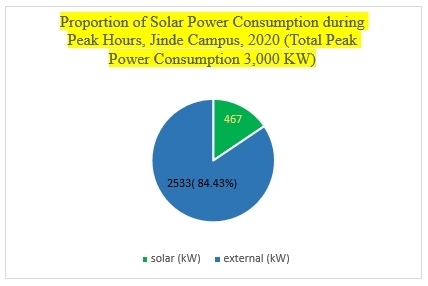
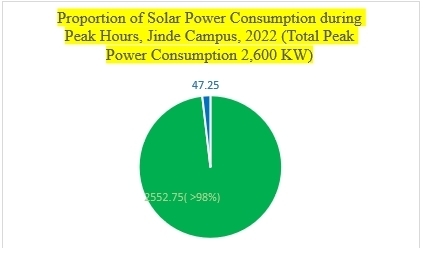

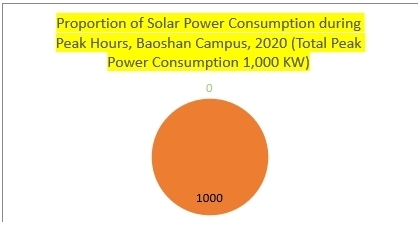
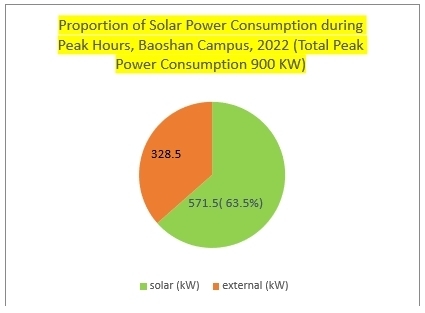
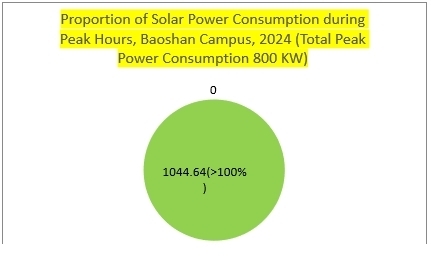
The following table presents the detailed distribution of new solar power generation facilities to be installed during academic year 2023–2024 (for each building)
|
Campus |
Building |
Expected Capacity (kWp) |
Total |
Expected Power Generation (kWh/year) |
Total |
|
Jinde |
No. 3 Dormitory |
259.94 |
510 .04kWp |
324,925 |
637,550 kWh |
|
No. 5 Dormitory |
69.7 |
87,125 |
|||
|
Parking lot at the East Gate |
102.5 |
128,125 |
|||
|
Left and right sides of the Torch Tower |
77.9 |
97,375
|
|||
|
Baoshan |
Behind No. 9 Dormitory |
138.99 |
473.14 kWp |
173,737 |
591,424 kWh |
|
Parking lot of No. 9 Dormitory, next to Baoshan Road |
123.41 |
154,262 |
|||
|
Parking lot of the First Educational Building, next to Baoshan Road |
113.98 |
142,475 |
|||
|
Parking lot of the Second Educational Building |
96.76 |
120,950 |
